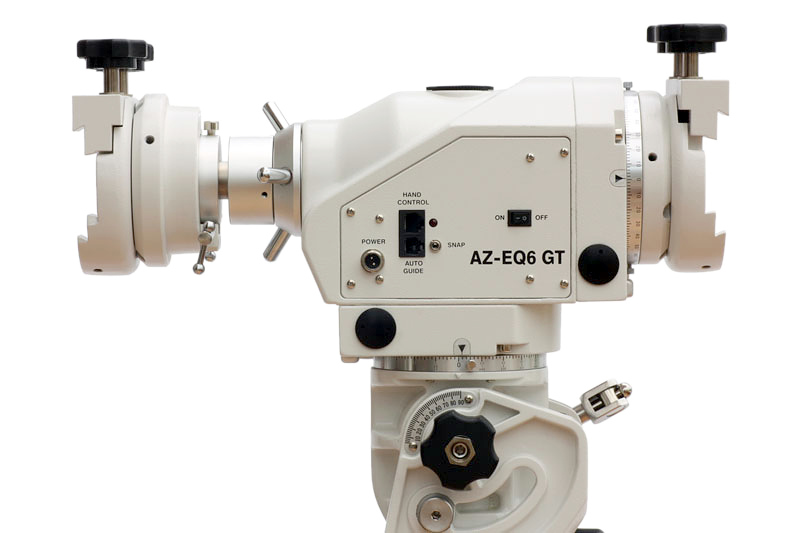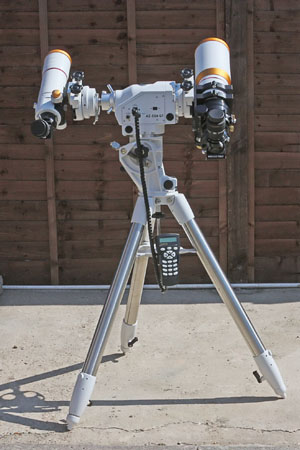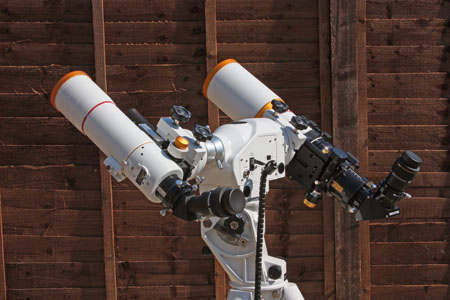Skywatcher AZ EQ6-GT Review Part-32 Comments15 September 2013 | Steve The new Skywatcher AZ EQ6-GT had a successful launch and has been well received. Customer feedback so far is excellent but there are still only a handful of reviews on the internet. So, to remedy this, we sent one to Steve Richards for a long-term review Steve Richards is the author of ‘Making Every Photon Count’ and writes for The Sunday Times, BBC Sky at Night Magazine and BBC Focus Magazine. Here is part-3 of his Skywatcher AZ EQ6-GT review - Altazimuth Mode and Final Summary. The first part of the review can be read here: Skywatcher AZ EQ6-GT Review Part-1 and part two here: Skywatcher AZ EQ6-GT Review Part-2.
Introduction
In part 1 of this long-term review I looked at the constructional features of the new mount with some general comparisons against the original NEQ6. This initial review was followed by a closer look at the mount when set up in Equatorial mode. In this final part of the review I’ll be looking at the mount from an observer’s point of view rather than an imaging one with the mount set up in Altazimuth mode. Altazimuth mounts track objects as they move across the sky, using two axes in discrete horizontal and vertical steps, unlike an Equatorial mount which tracks objects in an arc using the movement of a single axis. Because of this movement, they can be set up in any position and don’t have to be polar aligned so set-up time is reduced. This stepped movement makes them unsuitable for long exposure imaging but they are fine for observational use where their more intuitive pointing makes them easier to use than an Equatorial mount. Although polar alignment is not required, the mount does need to be mapped to the night sky and this is achieved by carrying out a simple 2 star alignment process. After this has been completed, you can choose celestial objects from the extensive 42,000 object database to slew to. The AZ-EQ6GT in useTwo star alignment is quick and straightforward. Choose a bright star in the night sky that you can readily identify and scroll through the list of alignment stars to find it, select it and then manually slew the mount using the direction keys on the handcontroller until the star is centred in the telescope’s finderscope and press the ‘Enter’ key. For the first part of the alignment, using the finderscope, you can also choose to undo the mount’s clutches and manually push the telescope until it is pointing at the first star. Finally, you centre the star through the eyepiece of the main telescope and press ‘Enter’ again. The system will ask you to select a second alignment star from the star list which will set the mount slewing to the new location using the position of the confirmed first alignment star as its known start point. Once the slew has been completed, you centre the star in the finderscope and then fine tune the pointing by centring it in the eyepiece of the main telescope. A final press of the ‘Enter’ key confirms the mount’s alignment. With alignment completed successfully, I set off on a journey of discovery to locate a wide range of objects in various locations in the night sky. Most objects appeared comfortably within the 2° field of view of my 17mm Hyperion eyepiece and 618mm focal length refractor but GoTo accuracy was not as good as it had been when using the mount in Equatorial mode. However, SkyWatcher are aware of this anomaly and are working on a solution that will be addressed in a future firmware upgrade.
Having tried the mount with a single telescope counterbalanced horizontally with one of the supplied weights, I then mounted a second, shorter focal length telescope, to the secondary dovetail saddle. This provided a very secure mounting and the fine adjustment of the altitude setting on the saddle assembly made it fairly easy to align the two telescopes with one another in the vertical axis. I found it very convenient and, to be honest rather fun, to swap between the narrower field of view of the larger instrument and the wider field of view of the smaller instrument so easily and I can see that dual telescope observing could become rather addictive! ConclusionThe SkyWatcher AZ-EQ6GT proved to be a very accessible mount when used in Altazimuth mode, was quick to assemble and align and great fun to use with two telescopes of different focal lengths and with differing eyepieces to allow the viewing of the same object at two different scales. SkyWatcher have an excellent reputation for resolving issues with their mounts (the earlier automated polar alignment routine issue being a recent example) and I have no doubt that the reduced pointing accuracy when using the mount in Altazimuth mode will be resolved in a forthcoming firmware upgrade. For very dim and more obscure objects, which by their very nature can be difficult to find through the eyepiece, I’d prefer to use the Equatorial mode, for its increased GoTo accuracy, until the revised firmware becomes available. Final SummaryHaving used this mount extensively over several months for both imaging and observing I was delighted with its performance. Being used to a fixed observatory platform, I did wonder if setting this instrument up each time for an imaging or observing session would be a chore but this was not the case and I often used the mount for observing while my imaging equipment in the observatory was working away on its own. The mount didn’t show any unusual behaviour at any time and performed as a very mature product, especially when used in Equatorial mode for either imaging or observing. Unless its duality is important to you, I wouldn’t suggest upgrading to the AZ-EQ6GT from the original NEQ6 but as an upgrade from any mount of lower performance or payload capacity than an NEQ6 this would be a very good choice indeed and it has certainly re-kindled this imager’s interest in observational astronomy!! Highly recommended!Steve Richards is the author of ‘Making Every Photon Count’ and writes for The Sunday Times, BBC Sky at Night Magazine and BBC Focus Magazine.
|
|








Read all three parts. First Class review.
Left me in no doubt that this mount is for me. Well done FLO!
I am looking to upgrade from an HEQ5 and only recently became aware of this mount's existence (how did I miss it?). Steve's review has certainly sold it me over the NEQ6.